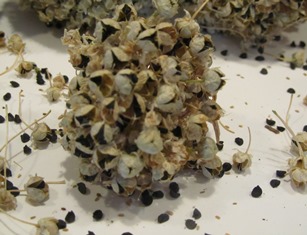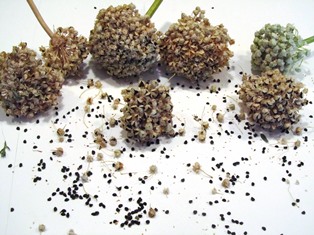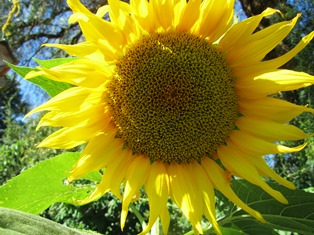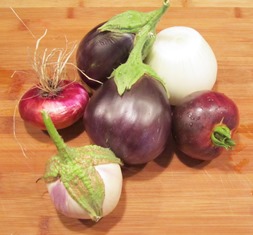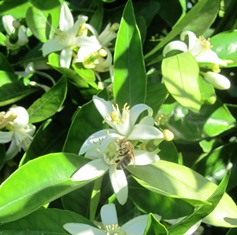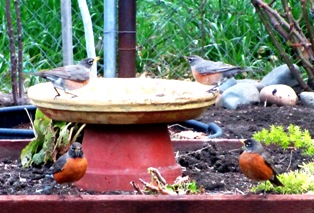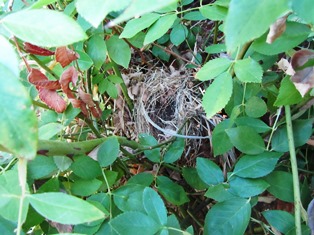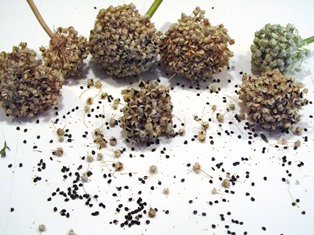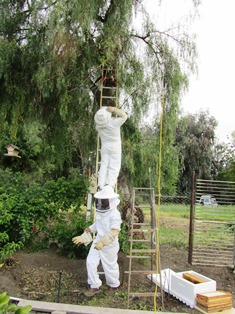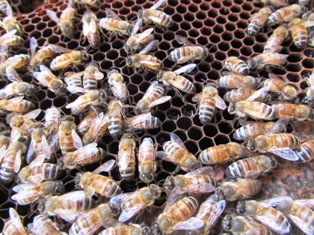Archive for August, 2013
Attracting Butterflies into Your Garden

The Western Tiger Swallowtail, shown here on geraniums, resembles its counterpart, the Eastern Tiger Swallowtail
While sipping my morning coffee today, I spotted a Western Tiger Swallowtail butterfly in my garden. So naturally, I had to put down my mug of coffee and grab my camera.
These beauties have wingspans stretching up to four inches. The butterflies are often seen in woodlands around streams and riverbanks or canyons in the west. For a complete list of butterflies for Northern California, see http://www.thebutterflysite.com/california-butterflies.shtml
Here on the farmette, these beautiful butterflies feed on the nectar of the garden plants. I often see them on the blooms of my hedge of lavender and elsewhere on the zinnias. They also flit over and and perched on the water fountain near where I grow roses and wisteria.
You can attract these particular butterflies into your Northern California gardens by planting petunia, Mexican sunflower, dianthus, and the butterfly bush. But do a little research on creating a butterfly garden if you want to attract different types of butterflies. And don’t use pesticides or insecticides if you are serious about creating such a haven.
Friends, Figs and Goat Cheese, and a Bee Swarm
Yesterday held a surprise for us. It was lovely late-summer weather, not too hot and not too cool. As my neighbor’s husband chatted with mine in the front yard, I went to the back of the farmette to work on pulling weeds from my garden. That’s when I heard the bees buzzing in flight. I saw them swarm.
It’s kind of late in the season for a bee swarm. All I can figure is that we fed the bees a week or so ago when we took honey and closed the hives for the fall. The hives are strong and one hive, in particular, must have had two queens.
So, I grabbed a metal lamp and a stick and began clanging to keep the swarm close and it alighted on the fence. My neighbor retrieved a box with some frames with wax and the swarm moved in.
The rest of my neighbor’s family, their children, and another family gathered on my patio. We shared wine and conversation. I put out a large cutting board of fresh strawberries, goat cheese, pistachios, and crackers and my neighbor brought over figs and a thin-crust pizza cut into slices.
It was an altogether lovely way to watch the sun go down on a late Sunday afternoon. I don’ t think we’ll have any more swarms this year. We’ve reduced the hive size and given the bees food to help them through the winter. Hopefully, the next swarms will occur in late spring–the right time for swarming.
Growing Onions from Seed
This afternoon, I harvested a basketful of onions (mostly red ones as I planted more of those in April than the yellow ones I use for soup). Red onions taste great in salads or sauteed with garlic and cooked into a sofrito that is added to beans.
I planted the onions in April in planter boxes that my husband built last year (four feet by six feet). This year, I put out sets. But since I’ve harvested seed this summer from the onions I grew from those sets, I will grow next year’s crop from the seed, starting them in seed flats in the kitchen in February.
Here’s how to grow onions from seed.
1. Sow the onion seeds about 1 inch deep in seed flats with seed starting mix.
2. Keep the soil moist and warm until the seeds germinate (about a 10 days to 2 weeks).
3. Keep the young onion shoots moist and warm as they grow.
4. In April or May after the ground outside has warmed sufficiently, replant the seedlings two to a hole about 4 to 6 inches apart in fertile, well-drained soil. (I lay my onion sets on the soil and cover lightly. They are shallow rooted. Do not plant too deep.
5. Water and remove weeds regularly.
6. Harvest onions in midsummer. Let dry in a dark, cool place.
Giant Sunflowers Are Fun for Kids and Easy to Grow
Today, I harvested the largest sunflower in my garden. The 119-inch stem (almost 10 feet) had bent over from the weight of the 15-inch seed head.
The seeds of this annual were already drying and starting to drop from the head. Since I want to harvest and store them, I don’t want to risk new plants emerging from where the seeds have drop onto soil. And I don’t want the squirrels to get the seeds before I’ve saved some.
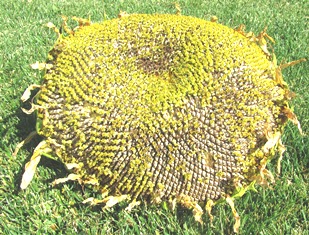
Giant sunflower head, newly harvested, covered with florets that will dry and fall off or can be brushed off to expose seeds
The sunflower I grew emerged from a single stalk that bore only one head with sunny yellow-petaled face. I planted it from seed I saved last year from the parent. If you want a row of giant plants, you’ll need to space them about 20 inches apart.
Kids love these giants when they are trained to grow in fairy rings, fortlike squares, or as tee-pees. The plants are much appreciated by the honeybees, squirrels, and songbirds. Best of all, the stalks can go into the compost pile when the growing season is over.
Our farmette soil is clay. In the area where I planted these sunflowers, I amended the soil with chicken manure and peat. The seedd went in about 1 inch deep and five to six inches apart. Last year, we grew the sunflowers in a circle, but this year we have a row at the back of the property in front of a fence.
Once the seeds are planted, a thorough watering will help them germinate within about a week. Keep them moist until they germinate, then water on a regular basis. I feed them once during the growing cycle with a cup of fish emulsion diluted in a five-gallon bucket of water. Otherwise they aren’t too fussy about soil and can even withstand some drought conditions.
Find heirloom organic seed that is non-GMO at any of the following seed companies:
Baker Creek Heirloom Seeds at http://www.rareseeds.com/mammoth-grey-sunflower/
Victory Seeds at http://www.victoryseeds.com/helianthus_annuus_giant.html
High Mowing Organic Seed at http://www.highmowingseeds.com/organic-seeds-mammoth-sunflower.html
Bountiful Gardens at http://www.bountifulgardens.org/products.asp?dept=70
All Good Things Organic or AGTO Seeds at http://www.agtoseeds.com/products/organic-russian-mammoth-sunflower-seed
Could the Weird Weather Be Affecting Our Crops?
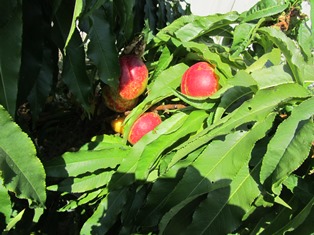
Nectarines are ripening but the tree recently developed peach leaf curl, noticeable in the top right leaves
Since the beginning of the agrarian age, farmers have understood that weather affects crops. To say the weather this year–at least in Northern California–has been weird is an understatement. I can’t help thinking it’s impacting my garden.
In the last three weeks, my healthy nectarine trees developed that dreaded fungal peach leaf curl, despite the prescribe spraying throughout the dormant season with horticultural oil. I’ve got tomato vines spreading everywhere with few tomatoes. The corn developed such a terrible infestation of corn aphids that I pulled out all the corn and fed it to the chickens.
I’m not blaming the weather for my all garden woes, but it’s got to be a factor in what my neighbors and I are witnessing in our gardens and orchards with regard to less bountiful crops.
We have to water because the soil is so dry it’s cracking open. We have to stay on top of pest infestations as we all grow organic and the bees travel through all of our backyards and up to five miles or so. We share our produce and stories of what’s happening in our gardens so we can deal with the problems.
We had very little rain during our rainy season and now local reservoirs are low. For the last three days, the Bay Area has had over 11,000 dry lightning strikes (putting fire departments on high alert), temperatures inching toward triple digits, and high particulate in the air because of all the wildfires burning in our state and elsewhere in the West.
I heard a recent newscaster using that dreaded word “drought” and lamenting about the low level of water currently available for farmers to use for their crops and orchards, especially in the California’s Central Valley, an area considered an important “bread basket” of the United States. The good news is that those farmers will be winding down their water usage as fall approaches and crops are harvested.
As the weather goes, so do the crops–something farmers and gardeners have always understood. My garden woes likely have a lot to do with the head gardener–that’s me. But I’ve been gardening here for four years and this year’s garden has been the least bountiful. While there are many factors to evaluate, the weird weather has to be considered.
Edible Flowers Add Flavor and A Flourish
Picture a red nasturtium or peppery-tasting marigold displayed around a mound of lemony-yellow butter. Or, imagine the beauty of a handful of sugared purple violets or red rose petals, sans the sour petal base, crowning an iced picnic cake.
During bygone eras when the Romans ruled the world or Queen Victoria reigned during the age named for her, flowers weren’t just for bouquets on the table, they formed an integral part of the food that was consumed.
Many flowers and seeds are poisonous, so it is imperative that you correctly identify any flower or plant you plan to eat or use on food. Also, make sure you are not allergic to the plant before integrating its blooms into your diet.
Several edible florals include the blossoms of herbs such as lavender, dill, garlic chive, coriander, basil, bee balm, marjoram, oregano, anise hyssop, winter savory, summer savory, sage, and mint. Also edible are the flowers of certain varieties of pumpkins, squash, cauliflower, scarlet runner bean, radish, sweet garden pea, and fennel.
Consider also the delicate blooms of society garlic, dianthus, pansy, signet marigold, red clover, African marigold, plum, scented geranium (rose, lemon). You can candy the blossoms of apple and crabapple, but the seeds are poisonous.
Some blooms, such as hibiscus (China rose), mint, rose, and chamomile are used to flavor teas. Lemon blossoms will have a slightly bitter taste whereas orange blossoms are sweet but both are lovely floating in crystal bowls of punch.
Research your chosen plant and correctly identify it before using it in any food preparation. See, http://www.extension.iastate.edu/publications/rg302.pdf
Also see, http://www.ext.colostate.edu/pubs/garden/07237.html
Forget the Lawn and Welcome the Robins
One of my favorite ways to relax is birdwatching. And nothing entertains me more than seeing an orange-breasted robin hopping around on the lawn and then halting at a full stop with its head cocked as if listening for an earthworm, as if the worms telegraphed their presence. I mean seriously. But somehow, those robins will find the worms and pull them right out of the ground.
When winter is nearing its close and spring is beginning, the robins are one of the first harbingers of the seasonal transition. In the spring, when other backyard birds are nesting and producing young, the robins are, too. But even though it is possible for them to produce three broods each year, less than half (40 percent) of their nests will hold baby robins.
Of the young robins that hatch, only about a quarter of them will make it to November each year. And as if that weren’t bad enough, of the robins that make it through a full year, only half will survive through a second year. And yet, robins can live to the ripe old age of 14 if it were not for predators and pesticides.
With the odds against these sweet birds’ survival, you’d think most people would not spray the daylights out of their lawns with pesticides and herbicides. These chemicals are toxic to the robins as well as other birds and, of course, the beleaguered honeybee.
Robins find lawns to be wonderful sites for foraging and I often see them searching and snatching the earthworms in the early morning. Later in the day, these cheerful birds seem to prefer fruit and honeysuckle berries. If you don’t see them, you might hear their cheery song crisp and clear, even over urban noise.
During certain times of the year, you might see the robins in greater numbers than at other times, but that doesn’t mean they’ve gone far. They are either resident birds, meaning they stay close to their breeding area or are short-distance migrants. The local conditions (environmental, weather, water and food availability, predator populations, and other factors) dictate the size of the robin population in at any given time in a particular area.
If you love birds as I do, less fussing over your lawn (except to encourage the worms) might mean having having more robins around. Consider ways to establish a healthy ecological balance in your yard and garden to avoid spraying with chemicals that can poison these cheerful fun-to-watch birds.
Harvesting Onions and Saving the Seeds
This year I grew Red Baron (red) onions from tiny sets. I pretty much just laid the thin little onion strings on the ground and sprinkled a little soil over them. I kept them wet and those little strings turned into really fat bulbs of purplish red onion with tall green stalks.
However, when the plant shot up some stalks that were two to three feet in height and sprouted a globe type bloom, I wasn’t sure what to do.Well, now I realize that those globes hold tiny black seeds that will turn into my next crop of onions.
When the bulbs started to turn a little dry, I clipped them and let them dry a bit more on my patio table. Then I laid them onto some white poster board and shook them vigorously to release the tiny black seeds (about the size of mustard seeds).
I put the seeds into a white paper envelope and then labeled the envelope with the name of the onion and the date the seeds were harvested. I can’t wait now until fall when I can sow the seeds into flats and then plant the new sets.
I got a lot of onions this year that I used in soups and salads. I can only hope that next year’s spring crop will be as bountiful.
A Swarm in July Isn’t Worth a Fly
There’s an old proverb about bees that goes: A swarm in May is worth a load of hay, a swarm in June is worth a silver spoon, but a swarm in July isn’t worth a fly. You might wonder why.
Well, I asked my beekeeper neighbor that question this morning as we suited up to feed the bees and take some frames of honey. The hives were thriving, bees were active, and the honey production copious. He harvested some, but also left some for the babies that the queen had produced.
There are spring flowers in May and new flowers in June, but by July many of the flowers that the bees love to forage on have flowered and gone to seed. If the queen lays lots of babies, where will the worker bees get enough pollen and nectar to support the entire hive, feed the queen, and supply the babies?
During fall in Northern California, the bees can forage on the eucalyptus blossoms, but then, they must survive through winter. I see bees on my December roses, but there aren’t a lot of flowers blooming in December that have high pollen and nectar loved by the bees.
Swarming in May and June is a sight to behold. Swarming is way the bees of deal with hive/nest overcrowding. It is how they increase their populations. See, http://entomology.unl.edu/beekpg/beeswarm.shtml.
A savvy beekeeper is ready to capture swarms as soon as the weather warms up in late spring. The bees won’t wait, although it is possible for a seasoned beekeeper to anticipate a swarm and take action to avert it. But it doesn’t always work.
An apiarist must manage his or her colony of hives and anticipate the needs and activities of the bees for the coming season–at this time of year, that means during fall and winter. Without a lot of food growing to support a new hive of bees from a captured swarm, a swarm in July isn’t worth a fly.
Skunks Snacking on Bees, Who Knew?
I had to do some searching around the Internet to beekeeping sites to find out whether or not skunks eat bees. Apparently they do.
The way it works, a skunk comes around in the early evening after sundown and will scratch on a hive until the guard bee or bees come straight out and then swats at them before eating the bees. Mother skunks even teach this behavior to their young.
My beekeeper neighbor keeps his hives elevated onto a bottom board platform. One would think this should ensure that the skunks would not bother the hive, but there is evidence lately of a skunk coming around.
Some of the telltale signs that a skunk might be raiding your hives are scratch marks on the hive, muddy prints if there’s a water source nearby, skunk feces (some may have dead bees in it), and dead bees on the ground in front of the hive.
When marauding mammals like skunks and raccoons get a taste for bees, a hive can die. Some suggestions I found searching around on the Internet include putting down tack strips (like those used to install wall-to-wall carpets).
Another is to put a screen around the hives (with an opening at the top for the bees to come and go) or place chicken wire in front of the hives. Skunks like standing on solid footing, not wire or mesh. A roll of mesh at the base of the hive could also be an effective deterrent.
You definitely want to get rid of the skunks. One can decimate a hive in a single night scratching, eating, throwing dirt until the bees get angry and come out in mass and then the skunk has a big meal. The hive thus weakened can be empty within a day or so.
 Facebook
Facebook Goodreads
Goodreads LinkedIn
LinkedIn Meera Lester
Meera Lester Twitter
Twitter





